Centipedes come in a variety of colours. Some of the most unusual are those that exhibit bright, eye-catching colours, such as those with yellow legs.
Contents
What is a centipede?
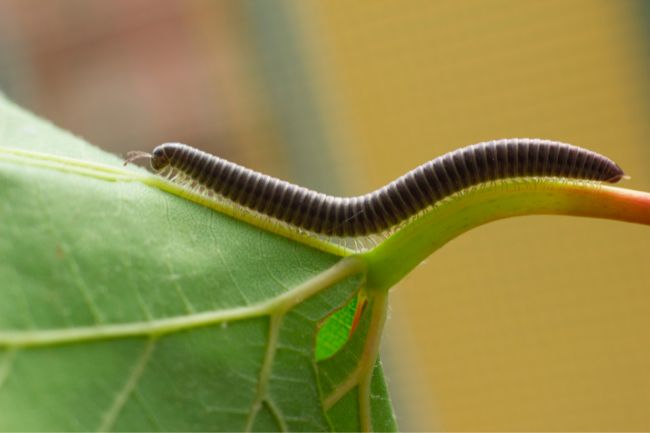
Centipedes are a group of arthropods with elongated bodies and one leg per body segment. This means that they can have between 15 and 177 pairs of legs, despite their name meaning 100 legs.
Centipedes are often confused with millipedes, which have two legs per body segment. As well as morphological differences, the two groups also have vastly different lifecycles, with millipedes being largely detritivores, eating dead wood and other plant matter. Centipedes by comparison are ferocious hunters, who feed on insects, amphibians and even small rodents in the case of some of the larger species.
In order to help them do this, they have a set of venomous claws at the front of their body, adapted legs they can use to inject venom into their prey. This can be extremely painful, even for larger animals such as humans.
There are around 3,000 centipedes across the world, though it is thought roughly 8,000 may exist. They are found on all continents aside from Antarctica and have adapted to live in a wide range of habitats, from rainforests to deserts.
Also read: Centipedes Have 100 Legs: Myth or a Reality (Let’s Explore)
Why are some centipedes yellow?
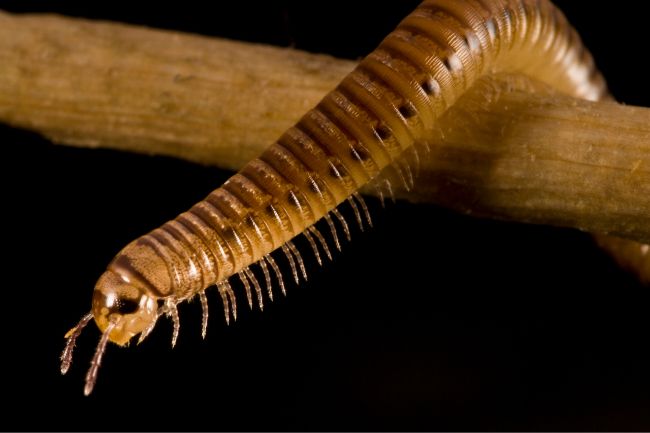
Many arthropods, such as insects, practice what is known as ‘warning colouration’. This is where they display bright colours and striking patterns to tell predators that they are equipped with some kind of defence. This may be a poison that the animal will ingest if they eat them, or it may be the fact they have fangs or a stinger.
While centipedes may not appear to be dangerous from the outside, many of them have venomous claws, with which they can cause a seriously painful nip. Not all centipedes decide to declare this, however, perhaps because they themselves are hunters, and they would rather remain camouflaged so as better to ambush their prey.
It may be that those most likely to opt for warning colouration are those that are more visible to larger predators, such as centipede species that spend more time in the open.
Also read: A List of 5 Centipedes with Blue Legs
Centipedes with yellow legs
Mediterranean banded centipede (Scolopendra cingulata)
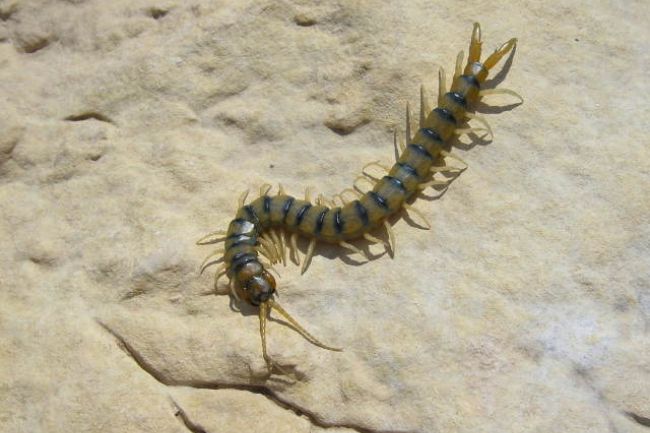
One of the most common centipedes in the Mediterranean, the Mediterranean banded centipede grows to around 15cm (5.9in) in length. With a yellowy brown body and distinctive yellow legs, this species gets its name from the dark bands found between each segment.
This species spends its time hunting under damp logs and in leaflitter. Despite its size its venom is not significant, and is likely to cause much other than temporary discomfort for humans or their animals.
Also read: A List of Centipedes that are Poisonous to our Pets
Chinese red-headed centipede (Scolopendra subspinipes mutilans)
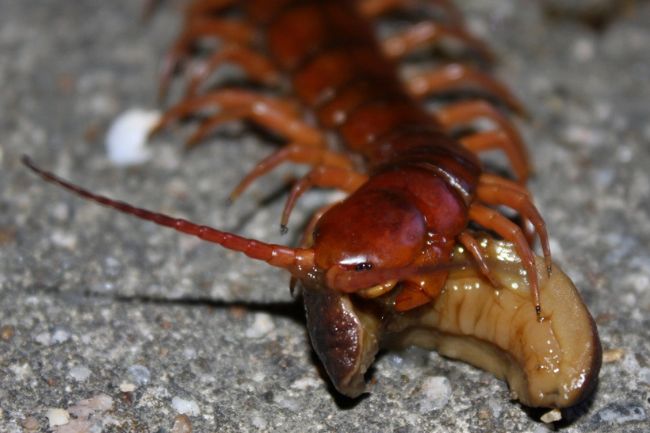
The Chinese red-headed centipede is found largely in China, and other East Asian countries, as well as Australia. This giant centipede can grow up to 20cm (7.87in) in length, and has a dark body with pale yellow legs, giving it a striking appearance.
Its venom can cause a painful sting, however it is not a particularly aggressive species.
Peruvian giant yellow-leg centipede (Scolopendra gigantea)
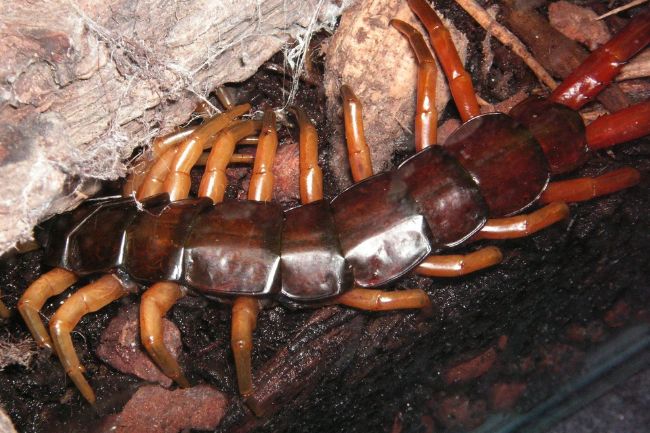
This giant centipede is the largest in the world, reaching an astonishing 30cm (11.81in) in length. While many centipedes hunt insects and other small arthropods, this centipede can catch anything from small rodents to reptiles.
Found in North America, as well as in parts of Central and Southern American, this centipede has a strong venom, that can be painful when bitten. With its brown body and striped yellow legs, it was very distinctive species.
Also read: A List of 4 Centipedes with Red Legs
Giant Desert Centipede (Scolopendra Heros)
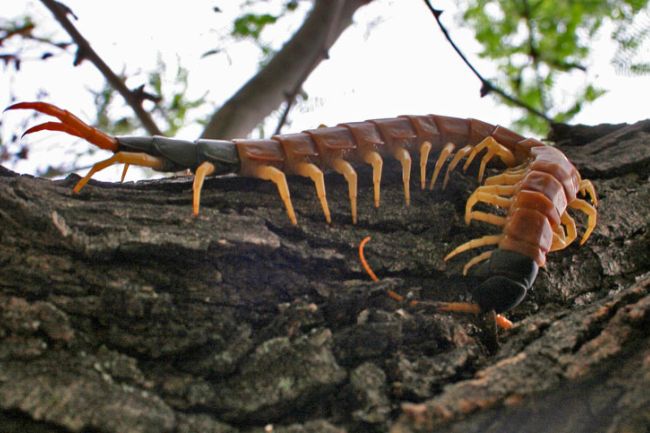
Found in dry habitats across the Southern United States and Mexico, this species reaches around 20 cm (7.87in) in length, and has a powerful venom. Humans bitten often find that they experience intense pain, though few deaths occur.
Like many other larger centipedes it feeds on small mammals and reptiles as well as insects. Though its colours can vary a great deal, one common colour variation is for it to have yellow legs and a brown body, with a darker head.
Other centipede species with yellow legs
| Centipede Species | Body Length | Number of Legs | Yellow Leg Coloration | Habitat Preference |
|---|---|---|---|---|
| Tiger Centipede | 4-6 inches | 30+ | Yellow or orange stripes | Forests, woodland areas |
| Yellow-legged Centipede | 1-2 inches | 30+ | Bright yellow legs | Gardens, moist areas |
| Golden-legged Centipede | 0.6-1.2 inches | 30+ | Golden-yellow legs | Leaf litter, soil |
| Sunburst Centipede | 0.8-1.2 inches | 30+ | Yellow legs with black bands | Damp environments |
A shocking yellow
Yellow is a very common colour used as part of warning colourations, you just have to look and bees and wasps with their black and yellow stripes and painful stings.
Another common aspect of warning colouration is pairing a bright colour with something contrasting. This may be why many of the centipedes mentioned have a dark body to go along with their yellow legs.
Still, despite their vicious bites and bright colours, centipedes mostly just want to be left alone. They’re too busy hunting much smaller creatures to want to use their venom on us.

